Corporation Law Assignment - Corporations Act 2001 and Director Duties
VerifiedAdded on 2021/06/14
|6
|1009
|135
Homework Assignment
AI Summary
This corporation law assignment addresses two key issues: the potential civil and criminal liabilities of company directors (Liam and Peta) when a company becomes insolvent and the actions that can be taken against a former director (Alexandra) for actions taken after leaving the company. The assignment analyzes the application of the Corporations Act 2001, particularly sections 95A, 588G, 588J, 588K, and 183, to the given scenarios. It examines the directors' responsibilities regarding insolvent trading, including the implications of incurring debt and potential penalties. The analysis also covers the concept of separate legal entities, director's fiduciary duties, and the misuse of company information. The document concludes that ASIC can pursue Peta for both civil and criminal proceedings, while only civil proceedings are possible against Liam. CloudTech can pursue Alexandra for breach of director duties regarding the use of its client list, but not the contract with Gnosis Records.
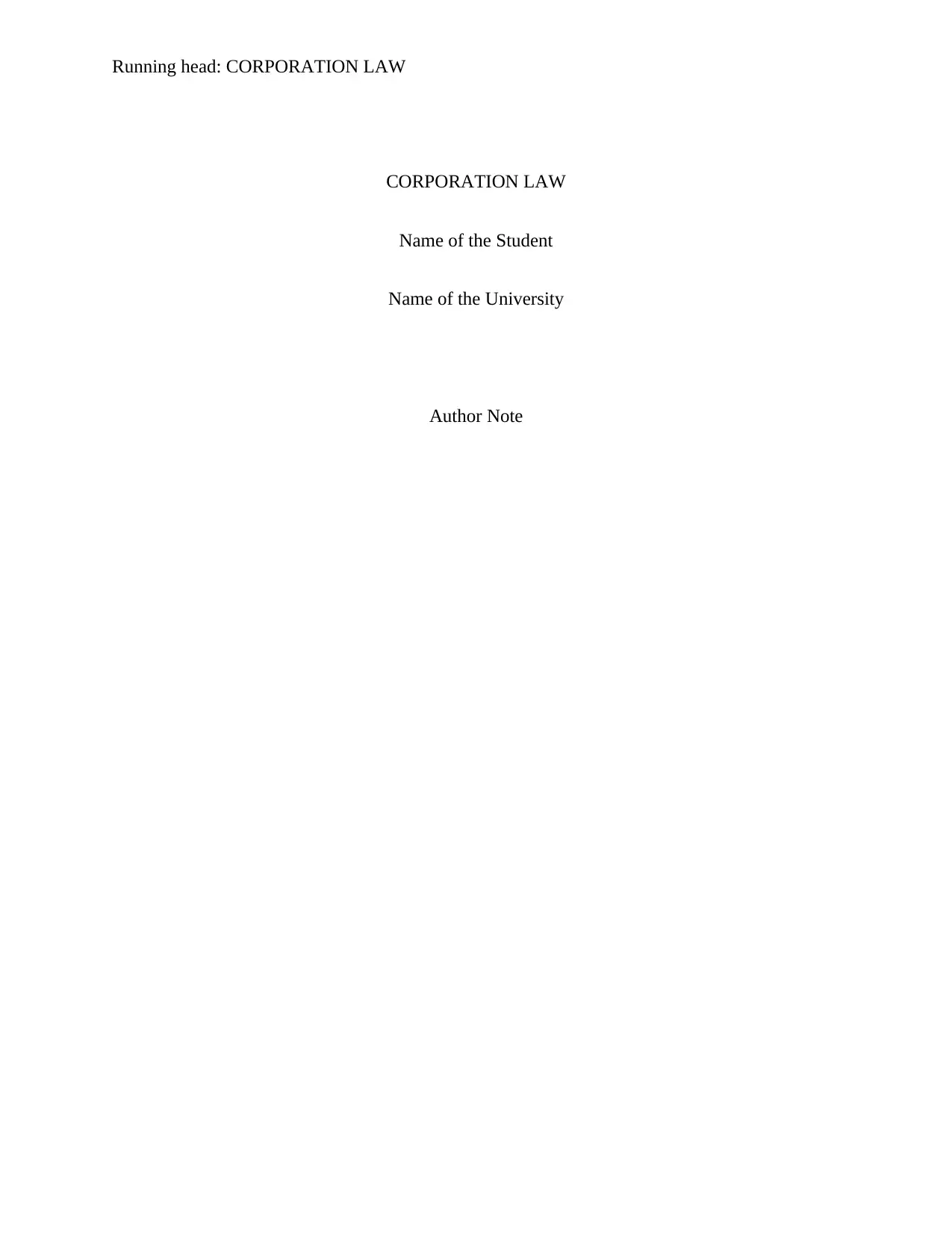
Running head: CORPORATION LAW
CORPORATION LAW
Name of the Student
Name of the University
Author Note
CORPORATION LAW
Name of the Student
Name of the University
Author Note
Paraphrase This Document
Need a fresh take? Get an instant paraphrase of this document with our AI Paraphraser
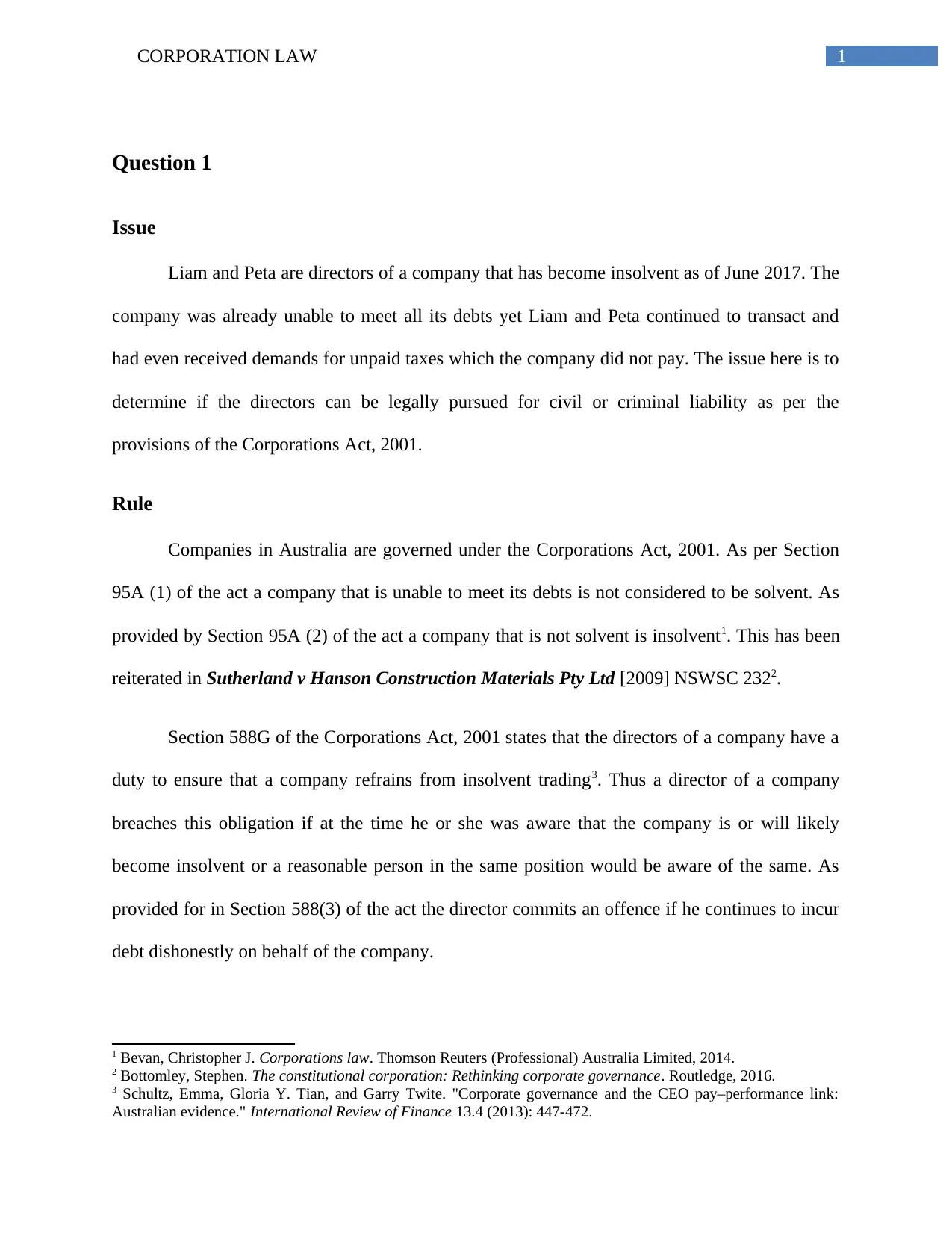
1CORPORATION LAW
Question 1
Issue
Liam and Peta are directors of a company that has become insolvent as of June 2017. The
company was already unable to meet all its debts yet Liam and Peta continued to transact and
had even received demands for unpaid taxes which the company did not pay. The issue here is to
determine if the directors can be legally pursued for civil or criminal liability as per the
provisions of the Corporations Act, 2001.
Rule
Companies in Australia are governed under the Corporations Act, 2001. As per Section
95A (1) of the act a company that is unable to meet its debts is not considered to be solvent. As
provided by Section 95A (2) of the act a company that is not solvent is insolvent1. This has been
reiterated in Sutherland v Hanson Construction Materials Pty Ltd [2009] NSWSC 2322.
Section 588G of the Corporations Act, 2001 states that the directors of a company have a
duty to ensure that a company refrains from insolvent trading3. Thus a director of a company
breaches this obligation if at the time he or she was aware that the company is or will likely
become insolvent or a reasonable person in the same position would be aware of the same. As
provided for in Section 588(3) of the act the director commits an offence if he continues to incur
debt dishonestly on behalf of the company.
1 Bevan, Christopher J. Corporations law. Thomson Reuters (Professional) Australia Limited, 2014.
2 Bottomley, Stephen. The constitutional corporation: Rethinking corporate governance. Routledge, 2016.
3 Schultz, Emma, Gloria Y. Tian, and Garry Twite. "Corporate governance and the CEO pay–performance link:
Australian evidence." International Review of Finance 13.4 (2013): 447-472.
Question 1
Issue
Liam and Peta are directors of a company that has become insolvent as of June 2017. The
company was already unable to meet all its debts yet Liam and Peta continued to transact and
had even received demands for unpaid taxes which the company did not pay. The issue here is to
determine if the directors can be legally pursued for civil or criminal liability as per the
provisions of the Corporations Act, 2001.
Rule
Companies in Australia are governed under the Corporations Act, 2001. As per Section
95A (1) of the act a company that is unable to meet its debts is not considered to be solvent. As
provided by Section 95A (2) of the act a company that is not solvent is insolvent1. This has been
reiterated in Sutherland v Hanson Construction Materials Pty Ltd [2009] NSWSC 2322.
Section 588G of the Corporations Act, 2001 states that the directors of a company have a
duty to ensure that a company refrains from insolvent trading3. Thus a director of a company
breaches this obligation if at the time he or she was aware that the company is or will likely
become insolvent or a reasonable person in the same position would be aware of the same. As
provided for in Section 588(3) of the act the director commits an offence if he continues to incur
debt dishonestly on behalf of the company.
1 Bevan, Christopher J. Corporations law. Thomson Reuters (Professional) Australia Limited, 2014.
2 Bottomley, Stephen. The constitutional corporation: Rethinking corporate governance. Routledge, 2016.
3 Schultz, Emma, Gloria Y. Tian, and Garry Twite. "Corporate governance and the CEO pay–performance link:
Australian evidence." International Review of Finance 13.4 (2013): 447-472.
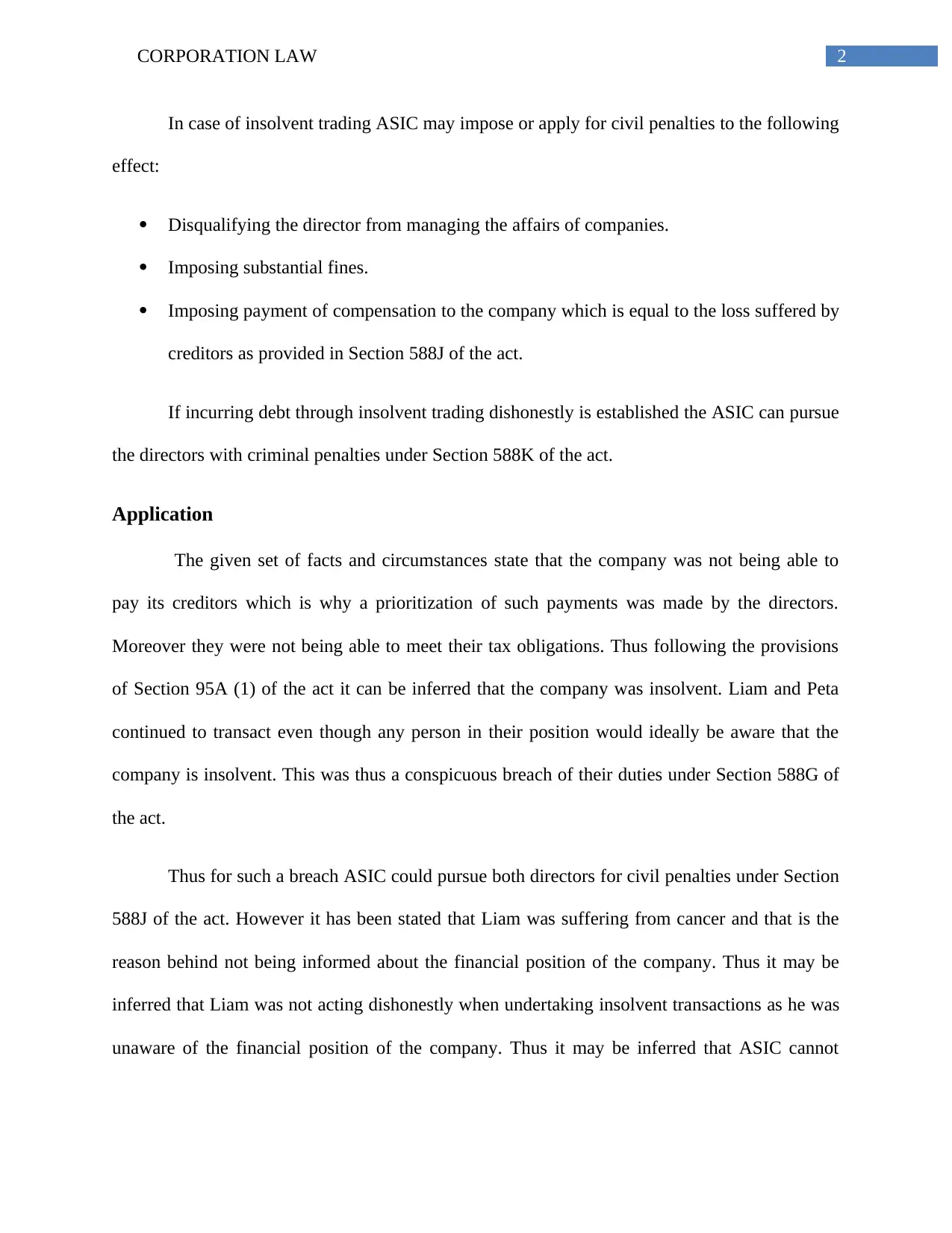
2CORPORATION LAW
In case of insolvent trading ASIC may impose or apply for civil penalties to the following
effect:
Disqualifying the director from managing the affairs of companies.
Imposing substantial fines.
Imposing payment of compensation to the company which is equal to the loss suffered by
creditors as provided in Section 588J of the act.
If incurring debt through insolvent trading dishonestly is established the ASIC can pursue
the directors with criminal penalties under Section 588K of the act.
Application
The given set of facts and circumstances state that the company was not being able to
pay its creditors which is why a prioritization of such payments was made by the directors.
Moreover they were not being able to meet their tax obligations. Thus following the provisions
of Section 95A (1) of the act it can be inferred that the company was insolvent. Liam and Peta
continued to transact even though any person in their position would ideally be aware that the
company is insolvent. This was thus a conspicuous breach of their duties under Section 588G of
the act.
Thus for such a breach ASIC could pursue both directors for civil penalties under Section
588J of the act. However it has been stated that Liam was suffering from cancer and that is the
reason behind not being informed about the financial position of the company. Thus it may be
inferred that Liam was not acting dishonestly when undertaking insolvent transactions as he was
unaware of the financial position of the company. Thus it may be inferred that ASIC cannot
In case of insolvent trading ASIC may impose or apply for civil penalties to the following
effect:
Disqualifying the director from managing the affairs of companies.
Imposing substantial fines.
Imposing payment of compensation to the company which is equal to the loss suffered by
creditors as provided in Section 588J of the act.
If incurring debt through insolvent trading dishonestly is established the ASIC can pursue
the directors with criminal penalties under Section 588K of the act.
Application
The given set of facts and circumstances state that the company was not being able to
pay its creditors which is why a prioritization of such payments was made by the directors.
Moreover they were not being able to meet their tax obligations. Thus following the provisions
of Section 95A (1) of the act it can be inferred that the company was insolvent. Liam and Peta
continued to transact even though any person in their position would ideally be aware that the
company is insolvent. This was thus a conspicuous breach of their duties under Section 588G of
the act.
Thus for such a breach ASIC could pursue both directors for civil penalties under Section
588J of the act. However it has been stated that Liam was suffering from cancer and that is the
reason behind not being informed about the financial position of the company. Thus it may be
inferred that Liam was not acting dishonestly when undertaking insolvent transactions as he was
unaware of the financial position of the company. Thus it may be inferred that ASIC cannot
⊘ This is a preview!⊘
Do you want full access?
Subscribe today to unlock all pages.

Trusted by 1+ million students worldwide
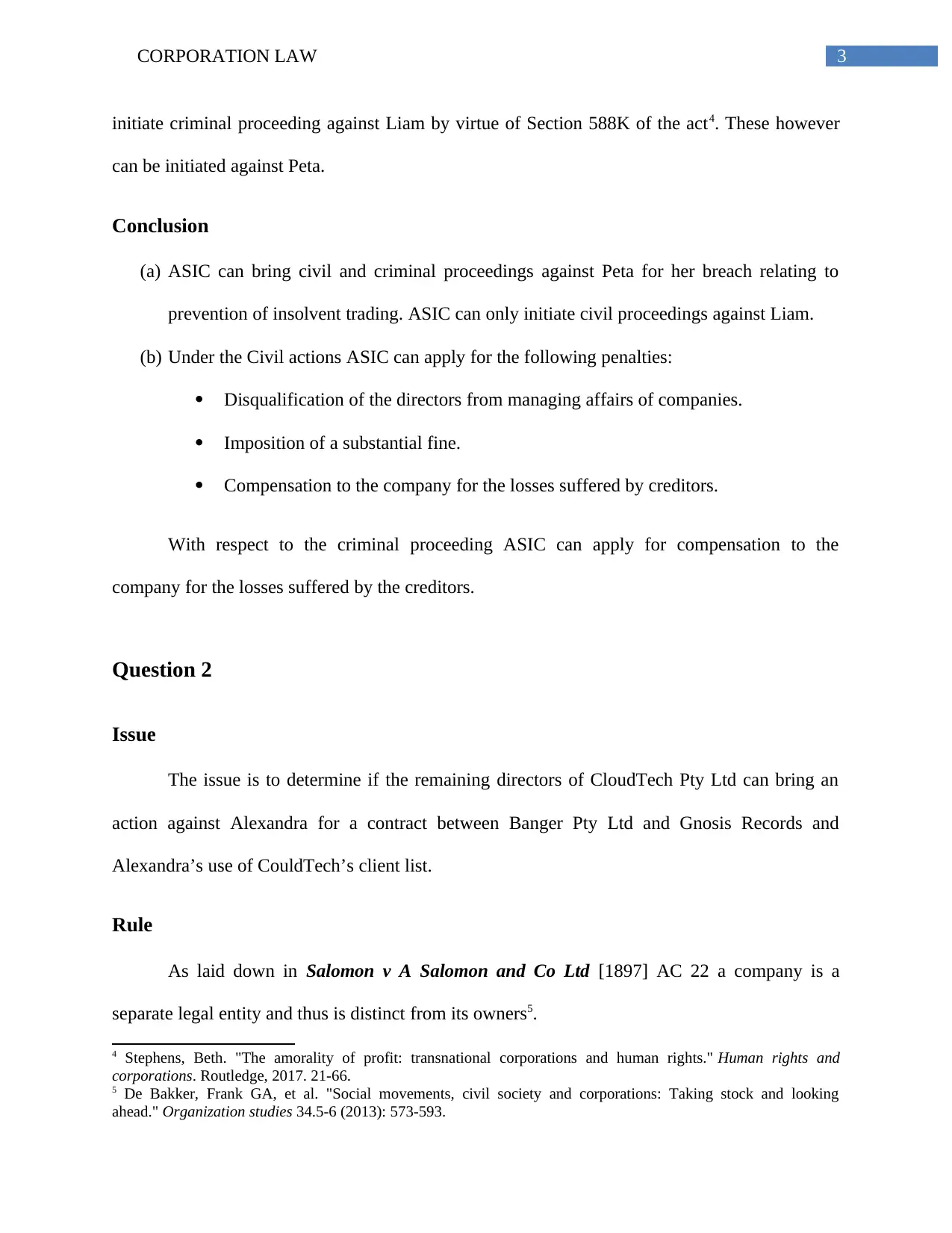
3CORPORATION LAW
initiate criminal proceeding against Liam by virtue of Section 588K of the act4. These however
can be initiated against Peta.
Conclusion
(a) ASIC can bring civil and criminal proceedings against Peta for her breach relating to
prevention of insolvent trading. ASIC can only initiate civil proceedings against Liam.
(b) Under the Civil actions ASIC can apply for the following penalties:
Disqualification of the directors from managing affairs of companies.
Imposition of a substantial fine.
Compensation to the company for the losses suffered by creditors.
With respect to the criminal proceeding ASIC can apply for compensation to the
company for the losses suffered by the creditors.
Question 2
Issue
The issue is to determine if the remaining directors of CloudTech Pty Ltd can bring an
action against Alexandra for a contract between Banger Pty Ltd and Gnosis Records and
Alexandra’s use of CouldTech’s client list.
Rule
As laid down in Salomon v A Salomon and Co Ltd [1897] AC 22 a company is a
separate legal entity and thus is distinct from its owners5.
4 Stephens, Beth. "The amorality of profit: transnational corporations and human rights." Human rights and
corporations. Routledge, 2017. 21-66.
5 De Bakker, Frank GA, et al. "Social movements, civil society and corporations: Taking stock and looking
ahead." Organization studies 34.5-6 (2013): 573-593.
initiate criminal proceeding against Liam by virtue of Section 588K of the act4. These however
can be initiated against Peta.
Conclusion
(a) ASIC can bring civil and criminal proceedings against Peta for her breach relating to
prevention of insolvent trading. ASIC can only initiate civil proceedings against Liam.
(b) Under the Civil actions ASIC can apply for the following penalties:
Disqualification of the directors from managing affairs of companies.
Imposition of a substantial fine.
Compensation to the company for the losses suffered by creditors.
With respect to the criminal proceeding ASIC can apply for compensation to the
company for the losses suffered by the creditors.
Question 2
Issue
The issue is to determine if the remaining directors of CloudTech Pty Ltd can bring an
action against Alexandra for a contract between Banger Pty Ltd and Gnosis Records and
Alexandra’s use of CouldTech’s client list.
Rule
As laid down in Salomon v A Salomon and Co Ltd [1897] AC 22 a company is a
separate legal entity and thus is distinct from its owners5.
4 Stephens, Beth. "The amorality of profit: transnational corporations and human rights." Human rights and
corporations. Routledge, 2017. 21-66.
5 De Bakker, Frank GA, et al. "Social movements, civil society and corporations: Taking stock and looking
ahead." Organization studies 34.5-6 (2013): 573-593.
Paraphrase This Document
Need a fresh take? Get an instant paraphrase of this document with our AI Paraphraser
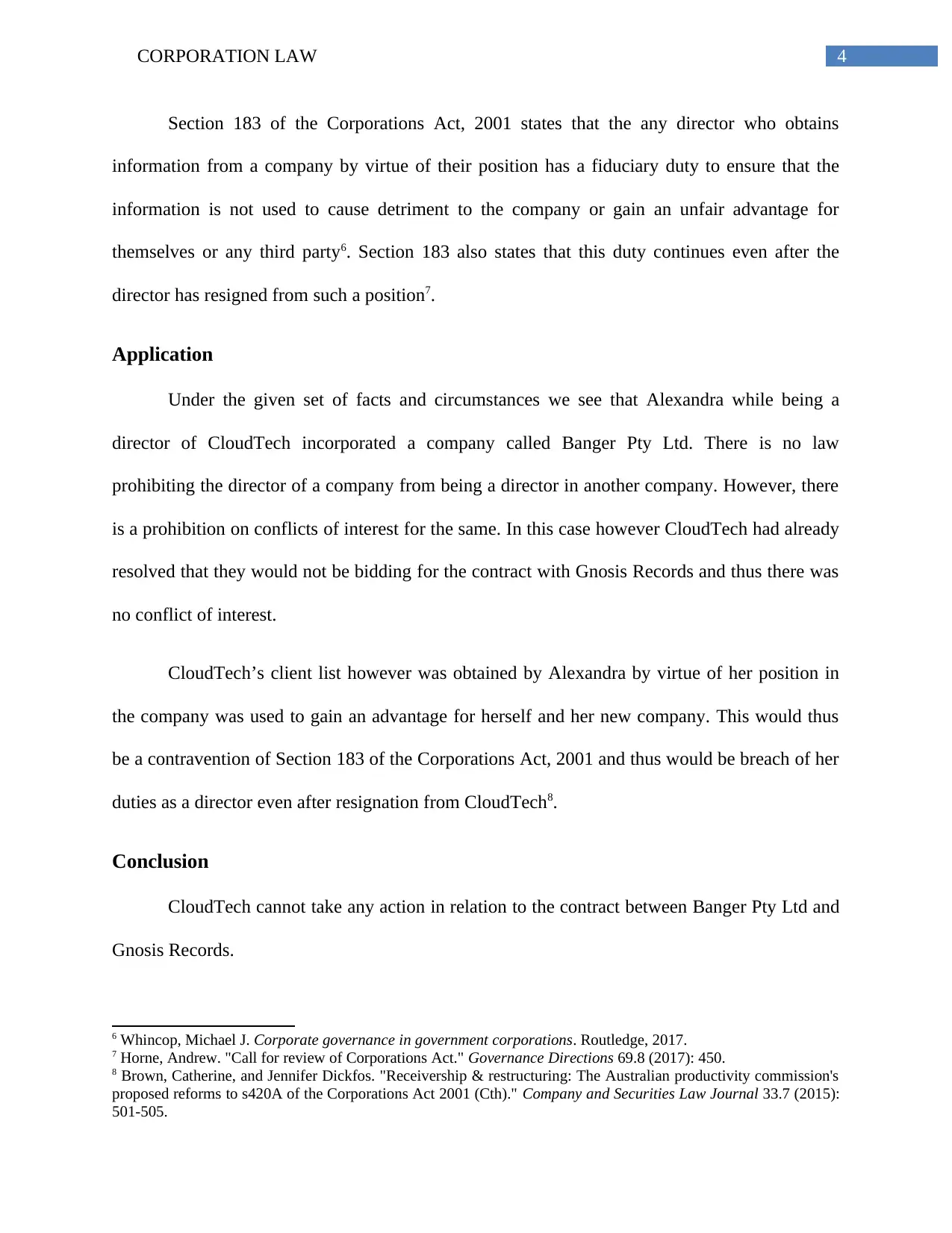
4CORPORATION LAW
Section 183 of the Corporations Act, 2001 states that the any director who obtains
information from a company by virtue of their position has a fiduciary duty to ensure that the
information is not used to cause detriment to the company or gain an unfair advantage for
themselves or any third party6. Section 183 also states that this duty continues even after the
director has resigned from such a position7.
Application
Under the given set of facts and circumstances we see that Alexandra while being a
director of CloudTech incorporated a company called Banger Pty Ltd. There is no law
prohibiting the director of a company from being a director in another company. However, there
is a prohibition on conflicts of interest for the same. In this case however CloudTech had already
resolved that they would not be bidding for the contract with Gnosis Records and thus there was
no conflict of interest.
CloudTech’s client list however was obtained by Alexandra by virtue of her position in
the company was used to gain an advantage for herself and her new company. This would thus
be a contravention of Section 183 of the Corporations Act, 2001 and thus would be breach of her
duties as a director even after resignation from CloudTech8.
Conclusion
CloudTech cannot take any action in relation to the contract between Banger Pty Ltd and
Gnosis Records.
6 Whincop, Michael J. Corporate governance in government corporations. Routledge, 2017.
7 Horne, Andrew. "Call for review of Corporations Act." Governance Directions 69.8 (2017): 450.
8 Brown, Catherine, and Jennifer Dickfos. "Receivership & restructuring: The Australian productivity commission's
proposed reforms to s420A of the Corporations Act 2001 (Cth)." Company and Securities Law Journal 33.7 (2015):
501-505.
Section 183 of the Corporations Act, 2001 states that the any director who obtains
information from a company by virtue of their position has a fiduciary duty to ensure that the
information is not used to cause detriment to the company or gain an unfair advantage for
themselves or any third party6. Section 183 also states that this duty continues even after the
director has resigned from such a position7.
Application
Under the given set of facts and circumstances we see that Alexandra while being a
director of CloudTech incorporated a company called Banger Pty Ltd. There is no law
prohibiting the director of a company from being a director in another company. However, there
is a prohibition on conflicts of interest for the same. In this case however CloudTech had already
resolved that they would not be bidding for the contract with Gnosis Records and thus there was
no conflict of interest.
CloudTech’s client list however was obtained by Alexandra by virtue of her position in
the company was used to gain an advantage for herself and her new company. This would thus
be a contravention of Section 183 of the Corporations Act, 2001 and thus would be breach of her
duties as a director even after resignation from CloudTech8.
Conclusion
CloudTech cannot take any action in relation to the contract between Banger Pty Ltd and
Gnosis Records.
6 Whincop, Michael J. Corporate governance in government corporations. Routledge, 2017.
7 Horne, Andrew. "Call for review of Corporations Act." Governance Directions 69.8 (2017): 450.
8 Brown, Catherine, and Jennifer Dickfos. "Receivership & restructuring: The Australian productivity commission's
proposed reforms to s420A of the Corporations Act 2001 (Cth)." Company and Securities Law Journal 33.7 (2015):
501-505.
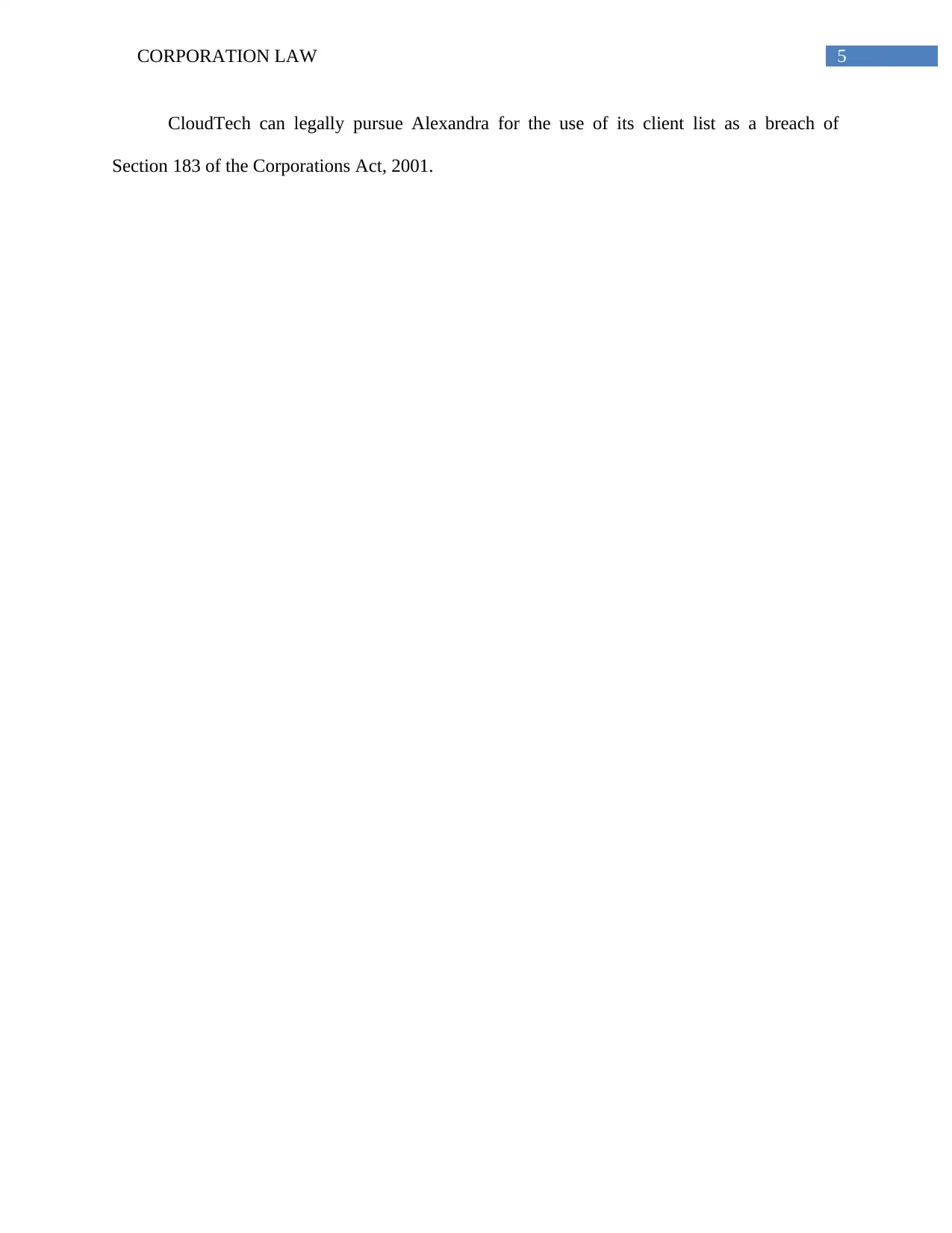
5CORPORATION LAW
CloudTech can legally pursue Alexandra for the use of its client list as a breach of
Section 183 of the Corporations Act, 2001.
CloudTech can legally pursue Alexandra for the use of its client list as a breach of
Section 183 of the Corporations Act, 2001.
⊘ This is a preview!⊘
Do you want full access?
Subscribe today to unlock all pages.

Trusted by 1+ million students worldwide
1 out of 6
Related Documents
Your All-in-One AI-Powered Toolkit for Academic Success.
+13062052269
info@desklib.com
Available 24*7 on WhatsApp / Email
![[object Object]](/_next/static/media/star-bottom.7253800d.svg)
Unlock your academic potential
Copyright © 2020–2025 A2Z Services. All Rights Reserved. Developed and managed by ZUCOL.




